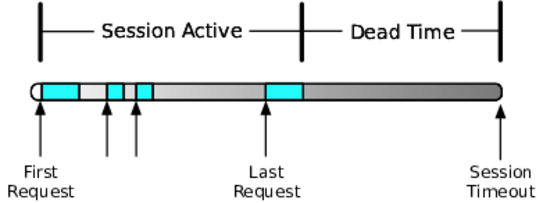Load Testing
With a new, untried system, the client knew that load testing would be critical to a successful launch. The client had budgeted a full month for load testing, longer than I’d ever seen. Before the site could launch, marketing had declared that it must support 25,000 concurrent users.
Counting concurrent users is a misleading way of judging the capacity of the system. If 100 percent of the users are viewing the front page and then leaving, your capacity will be much, much higher than if 100 percent of the users are actually buying something.
You can’t measure the concurrent users. There’s no long-standing connection, just a series of discrete impulses as requests arrive. The servers receive this sequence of requests that they tie together by some identifier. As shown in the following figure, this series of requests gets identified with a session—an abstraction to make programming applications easier.

Notice that the user actually goes away at the start of the dead time. The server can’t tell the difference between a user who is never going to click again and one who just hasn’t clicked yet. Therefore, the server applies a timeout. It keeps the session alive for some number of minutes after the user last clicked. That means the session is absolutely guaranteed to last longer than the user. Counting sessions overestimates the number of users, as demonstrated in the next figure.

When you look at all of the active sessions, some of them are destined to expire without another request. The number of active sessions is one of the most important measurements about a web system, but don’t confuse it with counting users.
Still, to reach a target of 25,000 active sessions would take some serious work.
Load testing is usually a pretty hands-off process. You define a test plan, create some scripts (or let your vendor create the scripts), configure the load generators and test dispatcher, and fire off a test run during the small hours of the night. The next day, after the test is done, you can analyze all the data collected during the test run. You analyze the results, make some code or configuration changes, and schedule another test run.
We knew that we would need much more rapid turnaround. So, we got a bunch of people on a conference call: the test manager, an engineer from the load test service, an architect from the development team, a DBA to watch database usage, and me (monitoring and analyzing applications and servers).
Load testing is both an art and a science. It is impossible to duplicate real production traffic, so you use traffic analysis, experience, and intuition to achieve as close a simulation of reality as possible. You run in a smaller environment and hope that the scaling factors all work out. Traffic analysis gives you nothing but variables: browsing patterns, number of pages per session, conversion rates, think time distributions, connection speeds, catalog access patterns, and so on. Experience and intuition help you assign importance to different variables. We expected think time, conversion rate, session duration, and catalog access to be the most important drivers. Our first scripts provided a mix of “grazers,” “searchers,” and “buyers.” More than 90 percent of the scripts would view the home page and one product detail page. These represented bargain hunters who hit the site nearly every day. We optimistically assigned 4 percent of the virtual users to go all the way through checkout. On this site, as with most ecommerce sites, checkout is one of the most expensive things you can do. It involves external integrations (CCVS, address normalization, inventory checks, and available-to-purchase checks) and requires more pages than almost any other session. A user who checks out often accesses twelve pages during the session, whereas a user who just scans the site and goes away typically hits no more than seven pages. We believed our mix of virtual users would be slightly harsher on the systems than real-world traffic.
On the first test run, the test had ramped up to only 1,200 concurrent users when the site got completely locked up. Every single application server had to be restarted. Somehow, we needed to improve capacity by twenty times.
We were on that conference call twelve hours a day for the next three months, with many interesting adventures along the way. During one memorable evening, the engineer from the load-testing vendor saw all the Windows machines in his load farm start to download and install some piece of software. The machines were being hacked while we were on the call using them to generate load! On another occasion, it appeared that we were hitting a bandwidth ceiling. Sure enough, some AT&T engineer had noticed that one particular subnet was using “too much” bandwidth, so he capped the link that was generating 80 percent of our load. But, aside from the potholes and pitfalls, we also made huge improvements to the site. Every day, we found new bottlenecks and capacity limits. We were able to turn configuration changes around during a single day. Code changes took a little longer, but they still got turned around in two or three days.
We even accomplished a few major architecture changes in less than a week.
This early preview of operating the site in production also gave us an opportunity to create scripts, tools, and reports that would soon prove to be vital.
After three months of this testing effort and more than sixty new application builds, we had achieved a tenfold increase in site capacity. The site could handle 12,000 active sessions, which we estimated to represent about 10,000 customers at a time (subject to all the caveats about counting customers). Furthermore, when stressed over the 12,000 sessions, the site didn’t crash anymore, although it did get a little “flaky.” During these three months, marketing had also reassessed their target for launch. They decided they would rather have a slow site than no site. Instead of 25,000 concurrent users, they thought 12,000 sessions would suffice for launch during the slow part of the year. Everyone expected that we would need to make major improvements before the holiday season.
